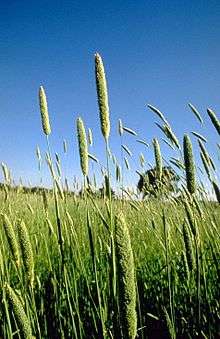Phalaris (plant)
| Phalaris | |
|---|---|
 | |
| Phalaris aquatica | |
| Scientific classification | |
| Kingdom: | Plantae |
| (unranked): | Angiosperms |
| (unranked): | Monocots |
| (unranked): | Commelinids |
| Order: | Poales |
| Family: | Poaceae |
| Subfamily: | Pooideae |
| Genus: | Phalaris L. |
| Species | |
|
15-22 species (see text) | |
Phalaris is a genus of grasses. Various species of Phalaris grow on every continent except Antarctica. They can be found in a broad range of habitats from below sea level to thousands of feet above sea level and from wet marshy areas to dry places. P. arundinacea and P. aquatica are sometimes invasive species in wetlands.
Alkaloids
Some Phalaris species are toxic to livestock containing gramine, which, in sheep and to a lesser extent in cattle, can cause brain damage, other organ damage, central nervous system damage and death.[1][2]
Phalaris arundinacea, Phalaris aquatica, and Phalaris brachystachys are known to contain the alkaloids N,N-DMT, 5-MeO-DMT, and 5-OH-DMT (bufotenin). Some research has been done into the variability of alkaloids in the Phalaris grasses. Strains with high levels of alkaloids are best avoided in locations with grazing cattle and sheep, due to potential toxicity. Such high-alkaloid strains include Phalaris aquatica AQ-1 and the species P. brachystachys. Seasonal and weather patterns also appear to affect alkaloid concentration, as most toxicity occurs in autumn and in times of drought. Regrowth after grazing or mowing also shows a considerable increase in alkaloids.
| Species | | | | |
| Phalaris aquatica | | | | |
| Phalaris arundinacea | | |||
| Phalaris brachystachys | | |||
None of the above alkaloids are said to have been found in P. californica, P. canariensis, P. minor and hybrids of P. arundinacea together with P. aquatica.[3]
Uses
Some species are used in dried flower arrangements. Phalaris canariensis is commonly used for birdseed.
Phalaris arundinacea is also being trialled as a potential bioenergy crop in Ireland.[5]
Species
Species include:
- Phalaris amethystina Trin.
- Phalaris angusta - timothy canarygrass
- Phalaris aquatica - bulbous canarygrass, Harding grass, Hardinggrass (syn. Phalaris tuberosa)
- Phalaris arundinacea - reed canary grass, reed canarygrass
- Phalaris brachystachys - shortspike canarygrass
- Phalaris californica - California canarygrass
- Phalaris canariensis - annual canarygrass, common canary grass, common canarygrass
- Phalaris caroliniana - Carolina canarygrass, maygrass, see Eastern Agricultural Complex
- Phalaris coerulescens - sunolgrass
- Phalaris commutata
- Phalaris elongata Braun-Blanq.
- Phalaris lemmonii - Lemmon's canarygrass
- Phalaris minor - canarygrass, littleseed canarygrass
- Phalaris paradoxa - hood canarygrass
- Phalaris platensis Henrard ex Wacht.
- Phalaris truncata Guss. ex Bertol.
References
- ↑ Toxicants of Plant Origin - Google Book Search. Retrieved 2008-04-20.
- ↑ phalaris pdf - AU Dept. of Agriculture and Food
- 1 2 3 Lycaeum
- 1 2 3 Erowid Phalaris FAQ
- ↑ Reed Canary Grass. Teagasc. 2007.
External links
- USDA Plants Database
- Grass Genera of the World
- Jepson Manual Treatment
- Erowid Phalaris Vault
- The genus Phalaris in Ayahuasca